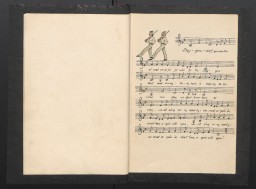
Artifact
Browse an alphabetical list of artifacts from the Holocaust and World War II. Each object tells a story about the history and demonstrates human experiences during the time period.
<< Previous | Displaying results 191-200 of 231 for "Artifact" | Next >>
-
Selma Engel diary entry about escaping during the Sobibor uprising
ArtifactDiaries reveal some of the most intimate, heart-wrenching accounts of the Holocaust. They record in real time the feelings of loss, fear, and, sometimes, hope of those facing extraordinary peril. Selma Wijnberg and Chaim Engel met and fell in love in the Sobibor killing center. After the young couple made a daring escape during the camp uprising and fled into hiding, Selma began a diary to record their experiences. The diary was written in 1943-1944 while Selma was in hiding in German-occupied…
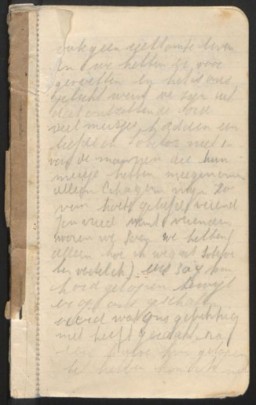
-
Selma Engel diary entry about life in hiding
ArtifactDiaries reveal some of the most intimate, heart-wrenching accounts of the Holocaust. They record in real time the feelings of loss, fear, and, sometimes, hope of those facing extraordinary peril. Selma Wijnberg and Chaim Engel met and fell in love in the Sobibor killing center. After the young couple made a daring escape during the camp uprising and fled into hiding, Selma began a diary to record their experiences. The diary was written in 1943-1944 while Selma was in hiding in German-occupied…

-
Sign excluding Jews from public places
ArtifactSigns excluding Jews, such as the sign shown here, were posted in public places (including parks, theaters, movie houses, and restaurants) throughout Nazi Germany. This sign states in German: "Jews are not wanted here."

-
Sign from Shanghai Ghetto
ArtifactOne of many signs displayed along the Shanghai ghetto's boundaries: "Stateless Refugees are Prohibited to Pass Here without Permission". This plaque was removed by a refugee at the end of the war. [From the USHMM special exhibition Flight and Rescue.]
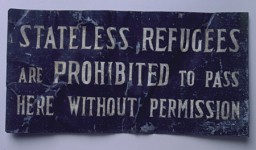
-
Silver kiddush cups of Caspary family
ArtifactGoblets used in Shanghai by the Caspary family for blessings (Kiddush) over wine on the Sabbath or Jewish holidays. The Orthodox Casparys ran a kosher restaurant frequented by yeshiva students from Poland. [From the USHMM special exhibition Flight and Rescue.]
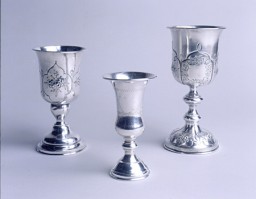
-
Singer sewing machine from the Lodz ghetto
ArtifactThis Singer sewing machine was used by shoemakers in the Lodz ghetto, Poland. As early as May 1940, the Germans began to establish factories in the ghetto and to utilize Jewish residents for forced labor. By August 1942, there were almost 100 factories within the ghetto. The major factories produced textiles, especially uniforms, for the German army.
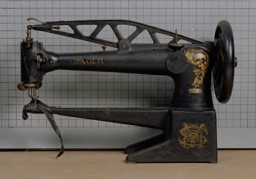
-
Sketch from a scrapbook presented during an inspection of Djelfa
ArtifactSketch from the scrapbook of Donald Coster presented to him during his inspection of the internment camp in Djelfa. The page is entitled, "All roads don't lead to Rome." Djelfa, Algeria, ca. 1941.

-
Sketch from scrapbook presented during inspection of Djelfa
ArtifactSketch from the scrapbook of Donald Coster presented to him during his inspection of the internment camp in Djelfa. The page is entitled, "Gulliver's travels to Djelfa." Djelfa, Algeria, ca. 1942.
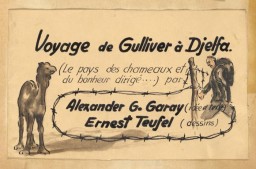
-
Small hooked rug used in the wagon of a Romani (Gypsy) family
ArtifactThis small patterned hooked rug was used as a shoe mat in the wagon of Rita Prigmore and her family when she was a child in Wurzberg, Germany, after World War II. Rita and her family were members of the Sinti group of Roma (Gypsies). She and her twin sister Rolanda were born in 1943. Rolanda died as a result of medical experiments on twins in the clinic where they were born. Rita was returned to her family in 1944. She and her mother survived the war and moved to the United States, before returning to…
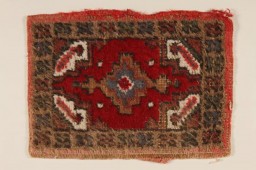
-
Songbook made by survivors at the Deggendorf displaced persons camp
ArtifactCarl Atkin was United Nations Relief and Rehabilitation Administration (UNRRA) director at the Deggendorf displaced persons camp. He received a songbook created by the survivors in his care. This page shows one of the songs compiled in the book.
